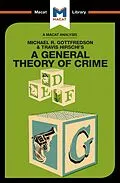Michael R. Gottfredson and Travish Hirschi's 1990 A General Theory of Crime is a classic text that helped reshape the discipline of criminology. It is also a testament to the powers of clear reasoning and interpretation.
In critical thinking terms, reasoning is all about presenting a solid and persuasive case - and as many people instinctively understand, the most persuasive reasoning is that which bases itself on a single, simple hook. In Gottfredson and Hirschi's case, this hook was what has come to be known as the "self-control theory of crime" - the idea that the tendency to commit crime is directly related to an individual's level of self-control.
While the dominant schools of thought of the time tended to focus on crime as the product of complex environmental factors, with little attempt to unify different theories, Gottfredson and Hirschi sought to interpret things so as to provide a single overarching concept that explained why crimes of all sorts were committed. Moreover, while other theories of crime concentrated on understanding and explaining specific types of law-breaking, the self-control model could, in Gottfredson and Hirschi's view, be seen as the basis for understanding the root cause for all crime in all contexts. While such simplicity inevitably attracted as much criticism as agreement, subsequent studies have provided real-world corroboration for the General Theory's persuasive reasoning.
Autorentext
Dr Bill Jenkins holds a PhD in Psychology from the University of Michigan. He is currently co-chair of the Department of Psychology at Mercer University.
Zusammenfassung
Michael R. Gottfredson and Travish Hirschi's 1990 A General Theory of Crime is a classic text that helped reshape the discipline of criminology. It is also a testament to the powers of clear reasoning and interpretation. In critical thinking terms, reasoning is all about presenting a solid and persuasive case - and as many people instinctively understand, the most persuasive reasoning is that which bases itself on a single, simple hook. In Gottfredson and Hirschi's case, this hook was what has come to be known as the "e;self-control theory of crime"e; - the idea that the tendency to commit crime is directly related to an individual's level of self-control. While the dominant schools of thought of the time tended to focus on crime as the product of complex environmental factors, with little attempt to unify different theories, Gottfredson and Hirschi sought to interpret things so as to provide a single overarching concept that explained why crimes of all sorts were committed. Moreover, while other theories of crime concentrated on understanding and explaining specific types of law-breaking, the self-control model could, in Gottfredson and Hirschi's view, be seen as the basis for understanding the root cause for all crime in all contexts. While such simplicity inevitably attracted as much criticism as agreement, subsequent studies have provided real-world corroboration for the General Theory's persuasive reasoning.
Inhalt
Ways In to the Text
Who were Michael R. Gottfredson and Travish Hirschi?
What does A General Theory of Crime Say?
Why does A General Theory of Crime Matter?
Section 1: Influences
Module 1: The Author and the Historical Context
Module 2: Academic Context
Module 3: The Problem
Module 4: The Author's Contribution
Section 2: Ideas
Module 5: Main Ideas
Module 6: Secondary Ideas
Module 7: Achievement
Module 8: Place in the Author's Work
Section 3: Impact
Module 9: The First Responses
Module 10: The Evolving Debate
Module 11: Impact and Influence Today
Module 12: Where Next?
Glossary of Terms
People Mentioned in the Text
Works Cited
